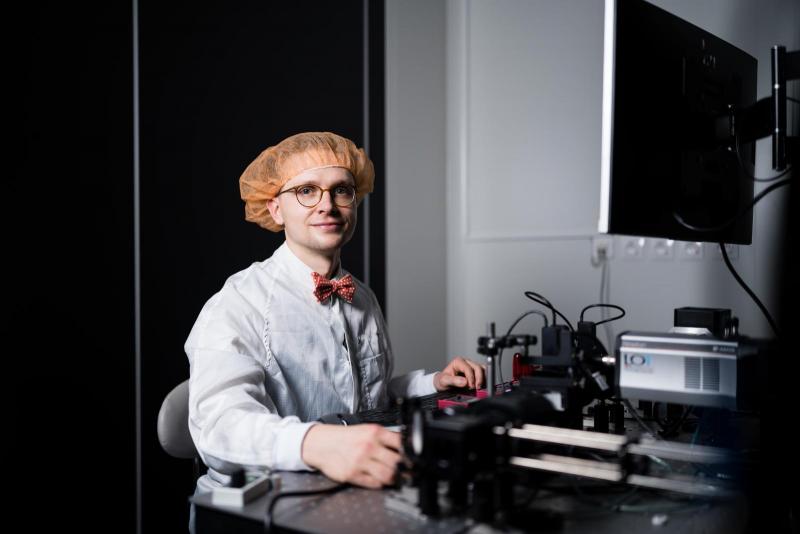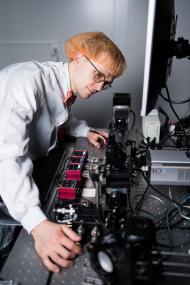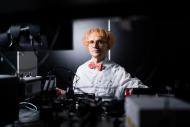People
A thin surface on the phone instead of four lenses. Metasurface will help us analyse our lunches one day

Not many people have probably heard the word metasurface. Yet we may soon start to encounter it on our mobile phones or in virtual glasses. Thanks to carefully designed nanostructures, it should be possible to shrink devices even further as their optical components will be removed. This is exactly what doctoral student Peter Kepič from CEITEC (Central European Institute of Technology) BUT (Brno University of Technology), who recently won a scholarship Brno Ph.D. Talent, is working on.
“Now there are often four lenses in a mobile phone, which allow it to make the best photos. Thanks to metasurfaces, all lenses could be replaced by an easily applicable thin surface, making the phone itself even thinner,” says Peter Kepič, a first-year doctoral student, describing one of the practical applications. Artificial nanostructures can be applied on a material and then change its properties or function. For example, when a surface is heated or charged with electricity, its optical properties begin to change. Such surface is called a metasurface and its advantage is that, unlike a conventional lens, it does not have to move back and forth to adjust, for example, the depth of field.
In addition to mobile phones, the layer finds potential application in virtual reality glasses, which today have a significant thickness not only because of the lenses and other optical components. “Nanostructures have the ability to incorporate all properties of the individual components and just apply them to a thin surface, so we are going from a bulky helmet to really thin glasses,” Kepič hints at future developments. However, the list of practical applications of metasurfaces does not end here.
Metasurfaces not only enable scaling down technologies, but can simply put, replace the function of a small spectrometer. Using just a laser beam, it will be possible to obtain a basic chemical analysis of the targeted object, which will help, for example, with the analysis of the quality and composition of food. “We can detect potentially harmful or toxic materials, so medicine and some very simple diagnostics are other fields of possible application. Although it is still a distant future, this technology will make it possible,” explains Kepič, who moved to CEITEC BUT after graduating from the FME (Faculty of Mechanical Engineering). It was here when he met his supervisor Tomáš Šikola, who now supervises him in the group for Preparation and Characterisation of Nanostructures.
Using just a laser beam, it will be possible to obtain a basic chemical analysis of the targeted object, which will help, for example, with the analysis of the quality and composition of food.
“During my studies at FME, I had already done some research at CEITEC, so I was familiar with the environment, the people and the way things worked here. However, I have been studying even before that and graduated in mathematics and physics in Bratislava before coming to Brno,” says the award-winning doctoral student on his career in research. Even though, as he says, he set an ambitious goal for himself in the Brno Ph.D. Talent competition; now, he can work on it for three years under the scholarship and he believes that his goal is achievable in that time.
“We all know what happens in the process of making chips and processors, how they keep getting smaller. Metasurfaces represent the next step on the road to removing conventional optical components and turning them into a thin surface. Artificially created nanostructures can be found in lenses, polarisers or holograms. So they have a wide range of applications,” adds Kepič. Another area where his research may one day help is quantum computers, as they involve a variety of optical components. “Their removal will lead to a radical reduction in the size of devices and technologies, and the end user may not even be able to see them anymore,” Kepič says.
Although nanostructures may be almost invisible, they can bring about major changes in our lives. Peter Kepič’s wife saw this when the scientist proposed to her by inscribing his proposal in a nanostructure thousands of times smaller than the thickness of a human hair, and then waited anxiously for his future wife to discover the inscription with an electron microscope. “I kept this particular sample as a souvenir,” concludes the talented young scientist with a smile.
Brno is an oasis of peace for me, I feel relaxed here, says Chinese doctoral student Xia
CEITEC scientist creates 3D model of a rare cave-dwelling salamander to facilitate its research
Awarded student Jiří Kabát uses an electron microscope to measure the temperature of nanoparticles
A student from BUT founds OMG Robotics and changes the way computer science is taught in Czech schools
The first woman at the head of the formula team has a great start

